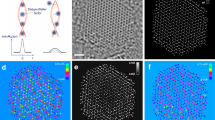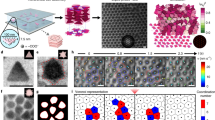Abstract
Coherent X-ray diffraction imaging is a rapidly advancing form of microscopy: diffraction patterns, measured using the latest third-generation synchrotron radiation sources, can be inverted to obtain full three-dimensional images of the interior density within nanocrystals1,2,3. Diffraction from an ideal crystal lattice results in an identical copy of this continuous diffraction pattern at every Bragg peak. This symmetry is broken by the presence of strain fields, which arise from the epitaxial contact forces that are inevitable whenever nanocrystals are prepared on a substrate4. When strain is present, the diffraction copies at different Bragg peaks are no longer identical and contain additional information, appearing as broken local inversion symmetry about each Bragg point. Here we show that one such pattern can nevertheless be inverted to obtain a ‘complex’ crystal density, whose phase encodes a projection of the lattice deformation. A lead nanocrystal was crystallized in ultrahigh vacuum from a droplet on a silica substrate and equilibrated close to its melting point. A three-dimensional image of the density, obtained by inversion of the coherent X-ray diffraction, shows the expected facetted morphology, but in addition reveals a real-space phase that is consistent with the three-dimensional evolution of a deformation field arising from interfacial contact forces. Quantitative three-dimensional imaging of lattice strain on the nanometre scale will have profound consequences for our fundamental understanding of grain interactions and defects in crystalline materials4. Our method of measuring and inverting diffraction patterns from nanocrystals represents a vital step towards the ultimate goal of atomic resolution single-molecule imaging that is a prominent justification for development of X-ray free-electron lasers5,6,7.
This is a preview of subscription content, access via your institution
Access options
Subscribe to this journal
Receive 51 print issues and online access
$199.00 per year
only $3.90 per issue
Buy this article
- Purchase on Springer Link
- Instant access to full article PDF
Prices may be subject to local taxes which are calculated during checkout




Similar content being viewed by others
References
Sayre, D. Some Implications of a theorem due to Shannon. Acta Crystallogr. 5, 843 (1952)
Miao, J., Charalambous, P., Kirz, J. & Sayre, D. Extending the methodology of X-ray crystallography to allow imaging of micrometre-sized non-crystalline specimens. Nature 400, 342–344 (1999)
Williams, G. J., Pfeifer, M. A., Vartanyants, I. A. & Robinson, I. K. Three-dimensional imaging of microstructure in gold nanocrystals. Phys. Rev. Lett. 90, 175501 (2003)
Cahn, R. W. Epitaxy keeps rolling along. Nature 375, 363–364 (1995)
Neutze, R., Wouts, R., van der Spoel, D., Weckert, E. & Hajdu, J. Potential for biomolecular imaging with femtosecond X-ray pulses. Nature 406, 752–757 (2000)
Patel, N. Shorter, brighter, better. Nature 415, 110–111 (2002)
Huldt, G., Szöke, A. & Hajdu, J. Diffraction imaging of single particles and biomolecules. J. Struct. Biol. 144, 219–227 (2003)
Bates, R. H. T. Fourier phase problems are uniquely solvable in more than one dimension. Optik 61, 247–262 (1982)
Hayes, M. H. The reconstruction of a multidimensional sequence from the phase or magnitude of its Fourier transform. IEEE Trans. Acoust. Speech Signal Process. 30, 140–154 (1982)
Fienup, J. R. Phase retrieval algorithms: a comparison. Appl. Opt. 21, 2758–2769 (1982)
Henderson, R. The potential and limitations of neutrons, electrons, and X-rays for atomic resolution microscopy of unstained biological molecules. Q. Rev. Biophys. 28, 171–193 (1995)
Eisebitt, S. et al. Lensless imaging of magnetic nanostructures by X-ray spectro-holography. Nature 432, 885–888 (2004)
Vartanyants, I. A. & Robinson, I. K. Partial coherence effects on the imaging of small crystals using coherent X-ray diffraction. J. Phys. Condensed Matter 13, 10593–10611 (2001)
Miao, J., Sayre, D. & Chapman, H. N. Phase retrieval from the magnitude of the Fourier transforms of nonperiodic objects. J. Opt. Soc. Am. A 15, 1662–1669 (1998)
Fienup, J. R. Reconstruction of a complex-valued object from the modulus of its Fourier transform using a support constraint. J. Opt. Soc. Am. A 4, 118–123 (1987)
McBride, W., O'Leary, N. L. & Allen, L. J. Retrieval of a complex-valued object from its diffraction pattern. Phys. Rev. Lett. 93, 233902 (2004)
Marchesini, S. et al. X-ray image reconstruction from a diffraction pattern alone. Phys. Rev. B 68, 140101 (2003)
Williams, G. J. Microscopy of Gold Microcrystals by Coherent X-ray Diffractive Imaging. PhD thesis, Univ. Illinois (2004).
Pfeifer, M. A. Structural Studies of Lead Nanocrystals using Coherent X-ray Diffraction. PhD thesis, Univ. Illinois (2004).
Heyraud, J. C. & Métois, J. J. Equilibrium shape and temperature: lead on graphite. Surf. Sci. 128, 334–342 (1982)
Wortis, M. in Chemistry and Physics of Solid Surfaces VII (eds Vanselow, R. & Howe, R.) 367 (Springer, Berlin, 1988)
Metzger, T. H. & Peisl, H. Huang diffuse x-ray scattering from lattice strains in high-concentration Ta-H alloys. J. Phys. F 8, 391–402 (1978)
Larson, B. C., Yang, W., Ice, G. E., Budai, J. D. & Tischler, J. Z. Three-dimensional X-ray structural microscopy with submicrometre resolution. Nature 415, 887–890 (2002)
Jacobsen, C. & Kirz, J. X-ray microscopy with synchrotron radiation. Nature Struct. Biol. 5, 650–653 (1998)
Acknowledgements
This research was funded by the NSF Division of Materials Research and the EPSRC. The UNICAT facility at the APS and the APS itself are supported by the US Department of Energy, the former through the Frederick Seitz Materials Research Laboratory.
Author information
Authors and Affiliations
Corresponding author
Ethics declarations
Competing interests
Reprints and permissions information is available at npg.nature.com/reprintsandpermissions. The authors declare no competing financial interests.
Supplementary information
Supplementary Figure 1
Animation showing the main result of the 3D visualisation of a strain field inside a Pb nanocrystal. This is a moving rendition of Fig 3(a) rotating about the substrate normal. A single isosurface of the phase and the best fit are superimposed on an image of the crystal density. The point defect lines used to generate the fit (dots) and the direction of Q (arrow) are also illustrated. (MPG 2140 kb)
Supplementary Figure 2
Raw coherent X-ray diffraction data measured for the Pb nanocrystal studied in this work. (PDF 391 kb)
Supplementary Figure 3
Isosurface views of the nanocrystal density, before (left column) and after (middle and right) performing the geometric correction. (PDF 47 kb)
Supplementary Figure 4
Sections of the real space density map of the crystal. (PDF 332 kb)
Supplementary Figure 5
Least-square fits of the shape of the boundary of the real space density map of the crystal. (PDF 765 kb)
Supplementary Figure 6
Sections of the real space phase map of the crystal. (PDF 16 kb)
Supplementary Figure 7
Plots of the density variation across rounded portions of the crystal (a), and across planar boundaries of the crystal (b-d). (PDF 793 kb)
Rights and permissions
About this article
Cite this article
Pfeifer, M., Williams, G., Vartanyants, I. et al. Three-dimensional mapping of a deformation field inside a nanocrystal. Nature 442, 63–66 (2006). https://doi.org/10.1038/nature04867
Received:
Accepted:
Issue Date:
DOI: https://doi.org/10.1038/nature04867
This article is cited by
-
Direct high-resolution X-ray imaging exploiting pseudorandomness
Light: Science & Applications (2023)
-
Probing three-dimensional mesoscopic interfacial structures in a single view using multibeam X-ray coherent surface scattering and holography imaging
Nature Communications (2023)
-
Strain and crystallographic identification of the helically concaved gap surfaces of chiral nanoparticles
Nature Communications (2023)
-
4th generation synchrotron source boosts crystalline imaging at the nanoscale
Light: Science & Applications (2022)
-
Three-dimensional in situ imaging of single-grain growth in polycrystalline In2O3:Zr films
Communications Materials (2022)
Comments
By submitting a comment you agree to abide by our Terms and Community Guidelines. If you find something abusive or that does not comply with our terms or guidelines please flag it as inappropriate.



